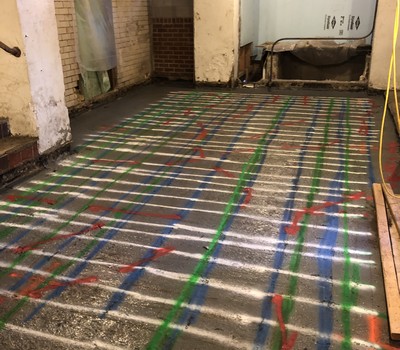Comprehensive Overview to Concrete Scanning Technologies
Comprehensive Overview to Concrete Scanning Technologies
Blog Article
Unveil the Transformative Power of Concrete Scanning in Maximizing Efficiency and Safety
Concrete scanning has become an essential tool in the building and construction sector, supplying unparalleled benefits in boosting project effectiveness and ensuring security criteria. By utilizing advanced innovation, concrete scanning permits professionals to see beyond the surface area, revealing covert intricacies that can impact the architectural honesty of a building. The transformative power of concrete scanning depends on its ability to give comprehensive understandings and real-time information, revolutionizing how tasks are prepared and executed. As we explore the complexities of this innovative strategy, a world of opportunities opens, showcasing a brand-new age of building methods that prioritize precision and protection.
Relevance of Concrete Scanning
Making sure the structural honesty and safety and security of building and construction jobs begins with the vital step of conducting extensive concrete scanning. Concrete scanning is a non-destructive technique utilized to find and map subsurface elements within concrete frameworks. This process is essential in determining possible hazards, such as rebar, post-tension wires, and channels, that may be concealed within the concrete. By using advanced modern technologies like ground-penetrating radar (GPR) and electromagnetic induction, construction teams can accurately find these aspects without causing any type of damage to the structure.
In addition, concrete scanning helps in enhancing task timelines and budget by staying clear of unexpected prices and delays that might arise due to unforeseen obstructions within the concrete. Ultimately, investing in comprehensive concrete scanning is a positive technique that boosts both performance and safety and security in building projects.
How Concrete Scanning Works
Concrete scanning operates as a critical tool in construction tasks by utilizing advanced modern technologies to detect and map subsurface aspects without triggering architectural damage. Ground Passing Through Radar (GPR) and Electromagnetic Induction (EMI) are two key techniques utilized in concrete scanning.
During the scanning procedure, the information accumulated is assessed in real-time, permitting instant recognition of prospective hazards or obstacles below the surface area. This info aids in decision-making, guaranteeing that building activities continue safely and efficiently. Additionally, 3D imaging software application can be made use of to develop topographic maps of the subsurface elements, better enhancing job planning and execution. By employing these sophisticated technologies, concrete scanning significantly lowers the danger of costly damages and injuries on construction sites.
Advantages of Concrete Scanning
Using sophisticated scanning modern technologies in building and construction tasks supplies a wide variety of advantages, improving both effectiveness and safety and security on-site. Among the primary benefits of concrete scanning is the capacity to find and find embedded objects such as rebar, post-tension cable televisions, and channels precisely. By recognizing these elements prior to drilling or cutting right into concrete frameworks, the threat of unexpected strikes is significantly reduced, avoiding possible injuries to employees and damages to the structure itself. Concrete scanning assists in preparation and designing much more successfully, as it provides accurate information concerning the place and deepness of architectural components.

Instance Studies: Concrete Scanning Success

In an additional case, a building and construction business utilized 3D concrete scanning to assess the condition old concrete structures in a historic structure. The thorough scans offered useful insights into the level of wear and tear and aided focus on maintenance initiatives successfully. By proactively resolving areas of concern recognized with scanning, the company had the ability to expand the lifespan of the structure and ensure passenger security.
These case researches emphasize the transformative power of concrete scanning in enhancing effectiveness, precision, and safety in building projects.
Applying Concrete Scanning in Projects
Applying innovative scanning innovations throughout construction tasks has become increasingly crucial for enhancing accuracy and safety and security. By incorporating concrete scanning right into task preparation and execution, building teams can identify potential risks, such as rebar or post-tension cable televisions, hidden within concrete structures. This proactive approach minimizes the risk of accidents, hold-ups, and pricey rework, image source eventually causing a lot more effective job timelines and budget plans.
To execute concrete scanning effectively, why not try this out task supervisors must work together carefully with skilled scanning experts to figure out the most suitable scanning techniques for the specific project requirements. Engaging scanning experts from the beginning of a project allows the group to create detailed scanning strategies that attend to crucial locations of concern and make sure extensive information collection.
Additionally, integrating concrete scanning into normal task workflows can streamline decision-making procedures, as real-time scan information supplies prompt insights right into the condition of concrete frameworks - Concrete Scanning. This data-driven technique facilitates informed analytic and makes it possible for groups to make modifications immediately, promoting a culture of effectiveness and security throughout the job lifecycle
Verdict
To conclude, concrete scanning plays a critical role in boosting performance and security in building and construction projects. By utilizing innovative technology to map and identify out underlying frameworks within concrete, this procedure helps to avoid expensive errors, guarantee structural stability, and decrease risks on site. With the ability to discover surprise elements and provide precise data, concrete scanning verifies to be an important device for maximizing project end results and taking full advantage of overall success.
Concrete scanning is a non-destructive technique used to detect and map subsurface components within concrete frameworks. Additionally, concrete Find Out More scanning aids in enhancing project timelines and spending plan by staying clear of unanticipated prices and hold-ups that might arise due to unexpected obstructions within the concrete. One notable case study entails a large-scale restoration project where concrete scanning played an important duty in ensuring task success.In an additional instance, a building and construction company used 3D concrete scanning to analyze the condition of maturing concrete structures in a historical structure. By incorporating concrete scanning into project planning and execution, building and construction teams can identify prospective risks, such as rebar or post-tension wires, hidden within concrete frameworks.
Report this page